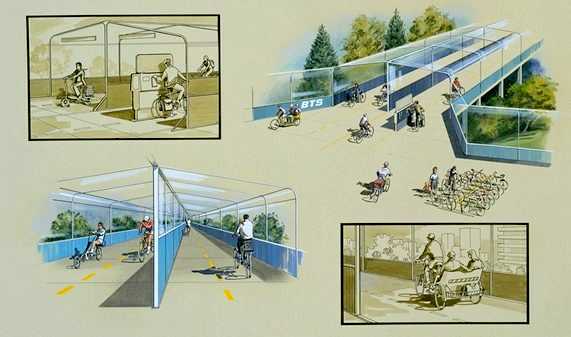JOHN S. ALLEN'S BICYCLE FACILITIES, LAWS AND PROGRAMS PAGES |
||
 |
 |
|
JOHN S. ALLEN'S BICYCLE FACILITIES, LAWS AND PROGRAMS PAGES |
||
 |
 |
|
Critique of Bicycle Transportation Systems "bicycle tunnel with tailwinds" proposal.Bicycle freeways in which bicyclists are propelled by artificially created tailwinds have been proposed many times, for several decades. A company by the name of Bicycle Transportation Systems, of Denver, Colorado, is currently promoting this concept. A drawing from the Bicycle Transportation Systems Web site illustrates the concept. Bicycle Transportation Systems claims that this system is "the future of mass transportation." |
 Drawing from Bicycle Transportation Systems Web site, |
| Does the claim of "the future of mass transportation" for these tunnels make
sense? In a word, no. Let's first look at the issue of energy efficiency. Bicycle Transportation Systems further states that "[c]ycling inside the Transglide 2000™ is 90% more efficient than normal cycling outside the enclosed airflow enhanced system." This statement accounts only for the energy expended by cyclists and ignores the energy necessary to propel air through the tunnel. The great majority of power would be expended in friction between the moving air and the tunnel walls. Prof. David Gordon Wilson has calculated power requirements as follows:
65 kW is approximately 100 hp. Note that this is a bare minimum power requirement, which assumes that there is only one entrance and one exit. The efficiency would be reduced by air leakage at entrances and exits. The leakage would brake rather than assist the cyclists at exits upstream of the main fan and entrances downstream of it. Multiple fans (drawing additional power) could maintain constant air speed along a tunnel's length despite the leakage, but only airlocks or revolving doors could eliminate power loss due to leakage. If air were moved in a circuit, in opposite directions on the two sides of the tunnel, minimizing the power loss would require sealing all entrances and exits except at a single location. A single opening could serve both entry and exit if it were at the opposite end of the tunnel from the fan; otherwise, it could serve either entering or exiting traffic, but not both. If there were a different fan for each direction of the tunnel, all entrances and exits except those at the ends of the tunnel would have to be sealed, and as bicyclists could not pass through the fan, there would also have to be a seal where the tunnel passes the fan to eliminate power loss due to backflow. In a long tunnel, there would be a noticeable (ear-popping) difference in air pressure on entering and leaving. Other issues:
Bottom line question: while I think that an argument can be made in favor of tailwind tunnels in terms of travel time (no waiting as with public transit, bicycle speeds made competitive with those of motor vehicles), would this system be competitive in popularity, safety and cost/benefit ratio with other options including bicycling in the open air, public transit (including bikes-on-transit) and private motor vehicles? Bicycling is a superb collector mode for public transit. The proposed tunnels would compete with public transit for users and funding, rather than supporting public transit as bike parking at transit stations and bikes-on-transit can. Even if it can be made as fast as public transit through artificial tailwinds or other means, bicycling can only partially substitute for public transit, because not everyone is able to ride a bicycle and because there may be the need to carry more baggage than can be carried on a bicycle. The tunnel concept does have one significant conceptual advantage: it works as a speed amplifier (like the bicycle itself) rather than as a total replacement for the cyclist's power input. In this way, it promotes physical fitness, unlike motor vehicles. But the same advantage is available with self-contained, more efficient and more flexible power sources. It is also available through the cyclist's increasing fitness and through more efficient bicycle design. I think that the tunnel concept might be useful under a very limited range of conditions (for example, where the route is flat, there is already a need for an enclosed right of way, and especially if natural winds can be directed into it). I think that as a rule, we had best leave tailwinds to Mother Nature and be thankful for them when we can enjoy them. More drawings, and descriptions of the tunnel system, are at the Bicycle Transportation Systems Web site. |
Contents , © 2001, John S. Allen |